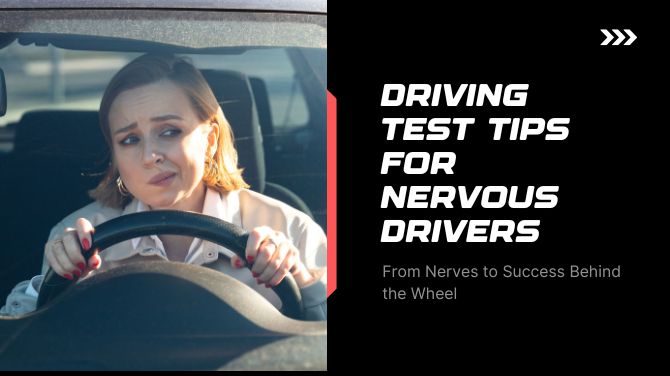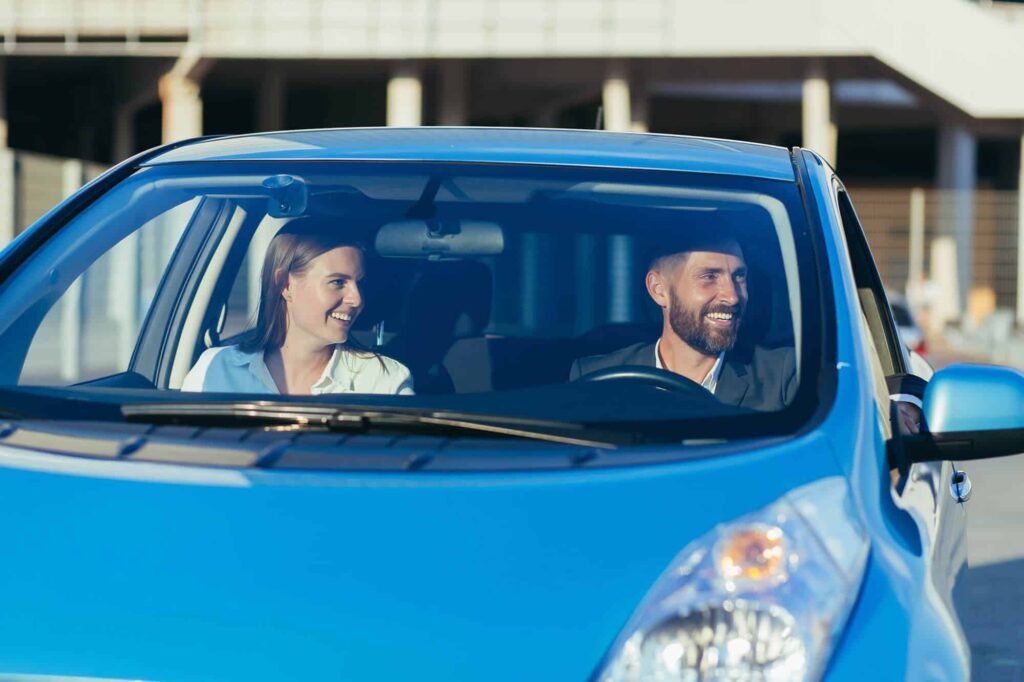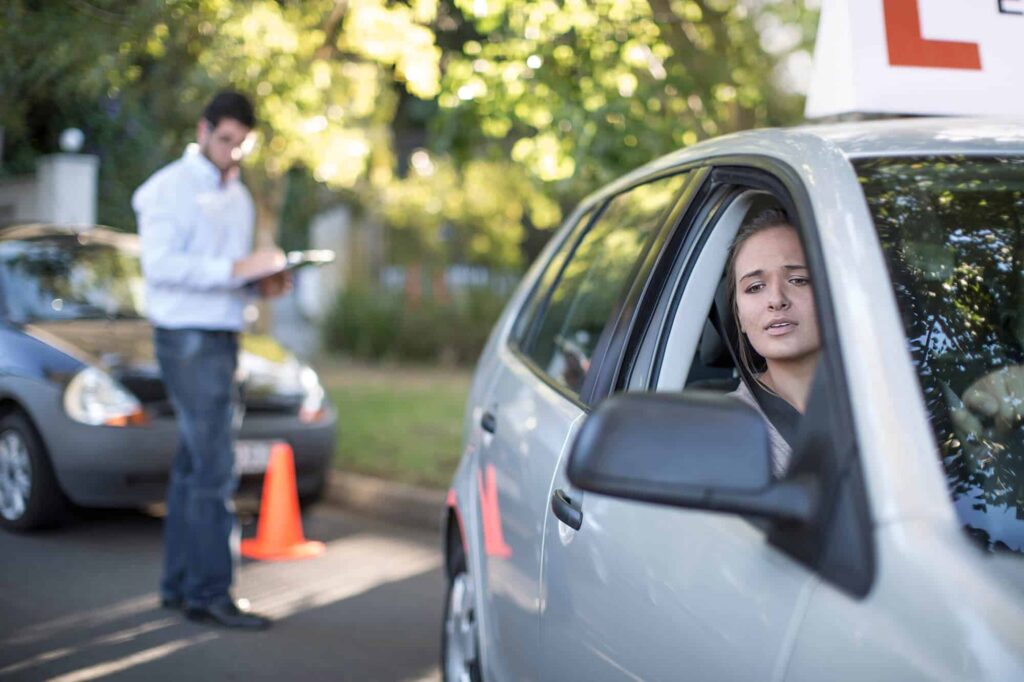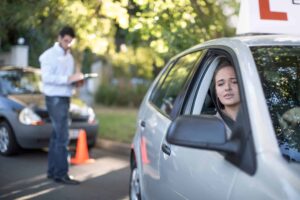You have been practicing for weeks, maybe months. You’ve circled empty parking lots, stalled at stop signs, or frozen at traffic lights, wondering if you’ll ever get the hang of it.
Now the big day is here, and your stomach is doing backflips. Your palms feel like they ran a marathon, and every time you blink, you imagine the examiner judging you silently.
This is completely normal. Even drivers who now cruise down the highway with coffee in one hand and music blasting were once in your exact shoes, sweaty palms included. Nervous drivers often become some of the best drivers.
The reason is simple: you care, you pay attention, and you are not taking the privilege of driving lightly. Examiners notice that.
One of my past students admitted she passed because, even though she made minor mistakes, she drove carefully and consciously throughout.
Think of this guide as a friend riding shotgun with you. Here, I will share driving test tips for nervous drivers, giving you pep talks, practical advice, and strategies just like a seasoned driving instructor would.
By the end, you will feel less like a bundle of nerves and more like someone ready to take on the road test with confidence.
Why nerves can be your ally?
Feeling nervous does not mean you are weak or unprepared. It shows that your brain understands the importance of the moment. Think of athletes before a big game: their hearts race, hands shake, and palms sweat. That adrenaline sharpens focus and improves reaction times.
A 2019 study found that moderate stress helps people perform better on tasks requiring focus. This means all those sweaty palms are actually your brain getting ready to pay attention to details that matter.
Pro Tip: Instead of thinking, “I am nervous,” say, “I am excited.” Your brain reacts similarly to both emotions. A mental shift like this can turn anxiety into energy, sharpening focus and alertness.
One student I taught would always get nervous at roundabouts. By reframing nervousness as excitement, she could focus on mirror checks and lane positioning, and she passed her test on the first try.
Must Check: How Many Questions Are on the G1 Test?
Driving Test Tips for Nervous Drivers
Sweaty palms and a racing heart? These driving test tips for nervous drivers will help you stay calm and confident.”
Preparing your mind before the test
Driving is as much mental as physical. If your mind is scattered, your driving will be too. Here are some ways to prepare:
Visualize success
The night before, close your eyes and picture yourself driving smoothly. See yourself signaling correctly, checking mirrors, stopping safely, and parking perfectly.
Hear the examiner say, “Congratulations, you passed.” Visualization primes your brain for success.
One learner imagined each turn, stop, and merge as a mini “success scenario,” which reduced panic during the real test.
Practice breathing
Nerves make your breath shallow. Try the 4-7-8 technique. Inhale for four seconds, hold for seven, and exhale for eight. Doing this even for a minute before starting helps calm your nervous system.
If your hands are shaking at the test center, take a moment to close your eyes and repeat this breathing. It works wonders.
Know the route
Practice around the test center if possible. Familiar roads reduce surprises. Knowing intersections, stop signs, tricky turns, or hills helps build confidence. One student kept panicking at a particular left turn. After practicing it five times in different traffic conditions, she said, “Now it feels automatic.”
Get enough sleep
A tired brain is slower at reacting and making decisions. Sleeping well before the test improves concentration and judgment. Even one extra hour of rest can make your reactions sharper, helping with merging, lane changes, and emergency stops.
Positive self-talk
Talk to yourself as you would to a friend: “I have practiced, I am ready, I can do this.” Studies show positive self-talk can reduce anxiety by up to 20 percent. Avoid saying “I hope I don’t fail.” Instead, affirm your preparation and skills.
Must Check: G2 Road Test Checklist
Taming test-day jitters
Your mindset and body condition on the morning of the test matter more than most people realize.
Arrive early
Aim to arrive 20 to 30 minutes early. Rushing spikes stress. Use the time to stretch, breathe, and observe the environment. Walk around the parking lot to release tension. One student I taught would tap the tires lightly to “wake up” his senses before starting.
Eat smart
Avoid heavy or greasy foods that make you sluggish. Choose light foods such as bananas, toast, yogurt, or eggs. A well-fed brain improves focus and reaction time. Stay hydrated but do not overdo it to avoid bathroom stress mid-test.
Wear comfortable clothes
Loose and flexible clothing improves comfort and movement. Tight jeans or stiff shoes can restrict movement, making it harder to control pedals or turn the wheel precisely. One student who switched to flexible running shoes passed her parallel parking test much more smoothly.
Warm-up drive
Drive 10 to 15 minutes with your instructor or a trusted family member. Think of it as stretching before exercise. It warms reflexes and calms nerves. Even a short drive around familiar streets helps your brain switch into “driving mode.”
Pro Tip: Before starting the test, say something positive aloud or in your head: “I have practiced this. I know what I am doing. I have got this.” It boosts focus and reduces anxiety.
Understanding the examiner
Many drivers see the examiner as a cold, judgmental figure. In reality, examiners are trained professionals whose goal is to see if you can drive safely. They expect minor mistakes but do not tolerate panic, recklessness, or ignoring rules.
Think of the examiner as a safety inspector rather than a judge. They are asking: Can this person drive without putting themselves or others at risk?
Small mistakes versus big mistakes
Minor mistakes do not automatically fail you. A mirror check slightly late or braking a little harder than needed is usually fine.
Major errors that can fail you instantly
- Running a stop sign or red light
- Speeding dangerously
- Almost hitting pedestrians or cyclists
- Ignoring basic traffic rules
Pro Tip: If you make a small mistake, take a deep breath and refocus. Examiners look at your overall performance, not isolated errors.
Driving with confidence
Confidence does not mean rushing or showing off. Imagine driving with someone you care about in the passenger seat. Steady, predictable driving wins points.
Examiners look for:
- Smooth acceleration and braking
- Proper mirror and blind spot checks
- Consistent adherence to speed limits
- Early and clear signaling
Mastering these basics is more important than flashy maneuvers.
Body language and breathing
Your body affects your mind. Hunching or gripping the wheel too tightly signals panic. Sit tall, relax your shoulders, and breathe.
- Hand placement: 9 and 3 positions, holding the wheel like a delicate sandwich
- Shoulders: Roll them back and relax
- Breathing: Take slow, deep breaths at red lights or before tricky maneuvers
Treat the wheel like a partner in a dance. Relaxed movements will feel natural and controlled.
Must Check: How Many Mistakes Are Allowed in G2 Test Ontario
Common nerve-inducing situations
Every learner driver faces moments that send their nerves into overdrive. Here are the situations that shake most people and how you can handle them.
Parallel parking
Examiners do not expect perfection. Focus on control, spacing, and safe stopping. Adjust as needed. One student hit the curb multiple times but finished with perfect alignment. The examiner valued smooth recovery.
Merging onto busy roads
Look, signal, merge. Missed a gap? Wait for the next safe opportunity. Safety always comes first.
Four-way stops
The first car to stop goes first. Tie? Yield to the right. Wave from other drivers? Proceed politely but confidently.
School zones and speed changes
Keep your eyes open, slow gradually, and anticipate changes. Safe reactions are always noticed.
Pro Tip: Narrate steps mentally: “Mirror, signal, blind spot, merge.” This keeps your mind focused and reduces stress.
Practice like it is the real test
Practicing in empty parking lots is helpful, but real-world driving is very different. Examiners want to see how you handle actual traffic, distractions, and unexpected situations.
Busy intersections
Practicing here helps you handle stop-and-go traffic, anticipate other drivers’ actions, and make safe decisions under pressure. One learner used to freeze at intersections.
After repeated practice, he started scanning, checking mirrors, and moving decisively, which increased his confidence.
Residential streets
These are perfect for practicing right-of-way rules, stop signs, and pedestrian awareness. Observing kids or pets that may suddenly enter the road prepares you for real-life scenarios.
Parking lots
Angle parking, reverse parking, and backing into spaces can feel tricky under exam pressure. Practicing slowly and systematically helps develop muscle memory.
One student spent a week mastering reverse parking in empty lots and then practiced in a busy lot to simulate exam pressure.
Highways
Merging, lane changes, and maintaining speed safely are essential. Many learners fear highway driving, but practicing gradually builds confidence. Start with off-peak hours, then gradually move to busier times.
Stat fact: According to Ontario driving statistics, learners who practice in varied conditions are 40 percent more likely to pass on their first attempt.
Reframing the test
Many learners see the driving test as a high-stakes, judgment-heavy event. It helps to change your mindset. The test is not about tricking you; it is about evaluating safe driving habits.
Think of the test as a job interview where your goal is to prove competence, not perfection. Pretend the examiner is a passenger who wants to get home safely. Focus on driving safely for their comfort rather than obsessing over flawless execution.
Shift your mindset
- You are not being “tested” in a scary sense. You are showing your skills.
- Safety and judgment matter more than perfectly aligned wheels.
- Recovering calmly from minor mistakes impresses examiners far more than flawless but nervous driving.
One learner forgot to signal at the beginning of a turn but remembered immediately and corrected it smoothly. The examiner noted her recovery and praised her situational awareness.
Handling the unexpected
Life on the road is unpredictable. Dogs, pedestrians, cyclists, or another car suddenly cutting in are common scenarios. Examiners are watching how you react, not whether these things happen.
Stay calm and controlled:
- Ease off the gas and brake gently when needed
- Scan mirrors constantly for situational awareness
- Make decisive but safe decisions
Examiners value judgment, composure, and awareness more than flawless execution. One learner panicked when a cyclist suddenly cut in but calmly slowed, checked mirrors, and merged safely.
She passed and later admitted it was a moment that could have gone wrong if she had panicked.
Must Check: Are there Any Quiet Areas in the GTA to Practice Driving?
Confidence loop
Confidence grows gradually and builds on small wins. Think of it as a feedback loop:
Prepare → Execute → Small Wins → Confidence → Less Nerves
Every practice session, every successful maneuver, and every recovered mistake builds trust in your skills. By test day, your confidence is solid.
A student kept stalling at stop signs during practice. After repeated attempts and feedback, he started recovering quickly each time.
By the actual test, he was smooth and calm because each small win reinforced his confidence.
Morning-of checklist
Test day can feel overwhelming. Here is a practical checklist to reduce stress:
| Task | Details | Why it matters |
| Essentials | License, documents, glasses/contacts | Needed to take the test |
| Breakfast | Light foods like banana, toast, or yogurt | Fuels brain and body without sluggishness |
| Warm-up drive | 10–15 minutes with instructor/family | Loosens muscles, wakes reflexes |
| Bathroom | Go before entering | Avoid distraction during test |
| Phone off | Silence devices | Keeps focus on driving |
| Water | Few sips | Keeps throat calm |
| Positive self-talk | “I have got this” | Boosts confidence |
| Arrive early | 20–30 minutes before | Reduces stress from rushing |
Pro tip: Use the early arrival time to observe other drivers calmly. Watch how they navigate intersections and stops. It primes your mind without adding stress.
What examiners love to see
Examiners notice habits more than flashy moves. Smooth, safe, and consistent driving stands out:
- Mirror checks done early and consistently
- Signaling clearly and in advance
- Thoughtful stopping at all stops, not just technically but with awareness
- Awareness of pedestrians, cyclists, and other vehicles
- Calm, consistent, and safe driving rather than flashy maneuvers
A learner who overthought parallel parking but drove safely and calmly through the rest of the route passed easily. Examiners care more about safe recovery and consistency than perfection in one task.
Using nerves as a superpower
It is normal to feel nervous before your driving test. Almost everyone does. The good news is that your nerves can actually help you.
- You notice more: Being nervous makes you check your mirrors and blind spots more carefully. This can help you avoid mistakes.
- You drive safer: Nerves often keep you from speeding or rushing. Driving at a safe speed shows the examiner you are careful.
- You spot hazards faster: You are more likely to see pedestrians, cyclists, traffic lights, and other cars early.
- You think before you act: Nervous drivers often pause for a moment before turning or changing lanes. That small pause can prevent accidents.
Use your nerves to stay alert and focused. The test is not about being fearless. It is about driving safely and showing awareness. Examiners usually prefer a careful nervous driver over someone who is too confident and takes risks.
Pep talk before you go
The test is not about perfection. It is about safe driving. Focus on:
- Basics: mirrors, signals, stopping, and speed
- Recovering calmly from mistakes
- Driving as if someone you care about is in the car
Passing the test means freedom, independence, and trust in your own abilities. That first solo drive, windows down, music on, will feel amazing.
Final thought
Passing your driving test is more than just getting a license. It gives you freedom, confidence, and the skills to drive safely. Feeling nervous is normal and shows that you care. Every practice session, small correction, and careful turn counts.
Examiners care more about staying calm and recovering from mistakes than being perfect. Focus on the basics, practice often, and keep your nerves in check to give yourself the best chance of success.
If you want extra help and guidance, Drive Zee, a top-rated MTO Approved Driving School in Toronto, can help you practice, gain confidence, and pass your test with ease. Enroll today and start driving with confidence.
Frequently Asked Questions (FAQ)
How many mistakes are allowed on the driving test?
You don’t have to be perfect. A few small mistakes are fine. What usually fails people are big safety issues like running a stop sign or making the same mistake again and again. Just drive safe and steady.
What if I stall the car during the test?
It happens. Take a breath, restart, check around you, and keep going. One stall is not a big deal. What matters is how quickly you calm down and carry on.
Can I ask the examiner questions?
Yes, but only if you need to. If you are not sure whether they said left or right, ask. They would rather you ask than guess. Just don’t start a full conversation.
How should I handle test-day nerves?
Everyone gets nervous. Try a few deep breaths, remind yourself you have practiced, and if you can, take a short drive before the test. Once you get moving, the nerves usually settle.
What if another driver does something unpredictable?
Stay calm. If someone cuts you off, give them space. If they honk, ignore it and keep following the rules. The examiner wants to see that you can handle these moments without panicking.






